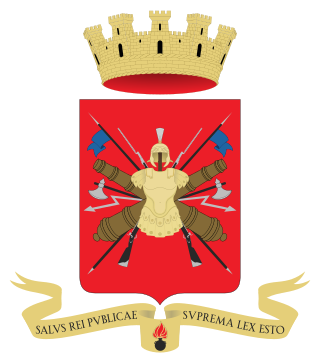
The Italian Army is the land force branch of the Italian Armed Forces. The army's history dates back to the Italian unification in the 1850s and 1860s. The army fought in colonial engagements in China, Libya, Northern Italy against the Austro-Hungarian Empire during World War I, Abyssinia before World War II and in World War II in Albania, Balkans, North Africa, the Soviet Union, and Italy itself. During the Cold War, the army prepared itself to defend against a Warsaw Pact invasion from the east. Since the end of the Cold War, the army has seen extensive peacekeeping service and combat in Afghanistan and Iraq. Its best-known combat vehicles are the Dardo infantry fighting vehicle, the Centauro tank destroyer and the Ariete tank and among its aircraft the Mangusta attack helicopter, recently deployed in UN missions. The headquarters of the Army General Staff are located in Rome opposite the Quirinal Palace, where the president of Italy resides. The army is an all-volunteer force of active-duty personnel.
On March 1, 1984 the Italian Institute for Disarmament, Development and Peace (Istituto di ricerche per il disarmo, lo sviluppo e la pace in Rome published the entire Italian Army order of battle down to company level – this was justified by the radical party as one of its core demands was total disarmament of Europe, even though the data which was published was top secret. The Radical Party dissolved in 1989 and the IRDISP followed suit in 1990. But Radio Radicale has survived, and the OrBat can still be found today on the homepage of the radio.

The Cavalry Brigade "Pozzuolo del Friuli" is a brigade of the Italian Army, based in the Friuli-Venezia Giulia and Veneto regions. The Brigade consists of a command unit, a cavalry regiment, an amphibious infantry regiment, an artillery regiment, an engineer regiment and a logistic regiment.

The Airmobile Brigade "Friuli" is an airmobile brigade of the Italian Army, based mainly in the Emilia-Romagna region. The brigade was part of the 1st Defence Forces Command until it was transferred to the Division "Friuli". The brigade's coat of arms depicts a stylized version of the Rocca di Monfalcone castle near the city of Monfalcone in the Friuli region, where the brigade distinguished itself during World War I. Since 1 July 2019 the brigade is part of the Division "Vittorio Veneto".

The 132nd Armored Brigade "Ariete" is currently the only active armored brigade of the Italian Army. Its core units are tank and Bersaglieri regiments. The brigade's headquarters is in Pordenone, and most of its units are based in the North-East of Italy. The brigade's name comes from the battering ram. The brigade draws much of its historical traditions from the 132nd Armored Division "Ariete," which fought in the Western Desert Campaign of World War II. In 1948, the Ariete was reconstituted as a division and remained active until 1986. Today the brigade is part of the Division "Vittorio Veneto".

The Mechanized Brigade "Brescia" was a mechanized brigade of the Italian Army. Its core units were mechanized infantry battalions. The brigade was founded in, named after, and headquartered in the city of Brescia and accordingly the brigade's coat of arms was modeled after the city's coat of arms.

The V Army Corps was one of three corps the Italian Army fielded during the Cold War. Based in the regions of Veneto and Friuli-Venezia-Giulia the corps was the army's main combat force. The 5th Army Corps was arrayed close to the Yugoslavian border and tasked with meeting any Warsaw Pact forces that crossed the border. On the left flank of the corps the 4th Alpine Army Corps was tasked with blocking the Alpine passes and in the rear of the corps the 3rd Army Corps served as operational reserve. After the end of the Cold War the corps was reduced in size and on 1 October 1997 it became the 1st Defence Forces Command. In 2013 the COMFOD 1° was disbanded and its function and brigades taken over by the 20th Infantry Division Friuli in Florence.

The Motorized Brigade "Cremona" was an infantry brigade of the Italian Army. The brigade's headquarters was in the city of Turin. The brigade carried on the name and traditions of the 44th Infantry Division "Cremona".

The Mechanized Division "Folgore" was a mechanized division of the Italian Army. Its core units were three mechanized brigades. The brigades headquarters was in the city of Treviso.
The following is a hierarchical outline for the Italian Army at the end of the Cold War. It is intended to convey the connections and relationships between units and formations.

The Mechanized Brigade "Isonzo" was a short-lived brigade of the Italian Army created during the 1975 army reform and renamed Mechanized Brigade "Mantova" during the 1986 army reform. The name of the brigade was chosen to commemorate the twelve Battles of the Isonzo during World War I.
With the 1975 reforms the Italian Army abolished the regimental level and replaced it with brigades made up of multiple arms. During the reform the army disbanded 48 regimental commands and reduced its force by 87 battalions. A further ten regimental commands were used to raise ten new brigade commands. Ten training centers, which for traditional reasons had carried the names of regiments, were also disbanded. The reduction in units also allowed to mechanize most of the remaining units in Northern Italy and Italy's defense strategy changed from a hold-at-all-costs territorial defense to one of mobile warfare.

The 63rd Tank Regiment is an inactive tank regiment of the Italian Army, which was based in Cordenons in Friuli-Venezia Giulia and last operationally assigned to the 132nd Armored Brigade "Ariete". The unit's lineage traces back to the World War II LXIII Tank Battalion L, which in 1940 participated in the Italian invasion of Egypt. The battalion was destroyed in December 1940 during the British Operation Compass. In 1961 the battalion was reformed and assigned to the 59th Infantry Regiment "Calabria". In 1964 the battalion was transferred to the Infantry Division "Mantova". In 1975 the battalion was renamed 63rd Tank Battalion "M.O. Fioritto" and assigned to the Mechanized Brigade "Isonzo". In 1991 the battalion entered the 63rd Tank Regiment "M.O. Fioritto", which in 1992 was renamed 63rd Tank Regiment. In 1995 the regiment was transferred from the Mechanized Brigade "Mantova" to the 132nd Armored Brigade "Ariete", however at the end of the same year the regiment was disbanded.
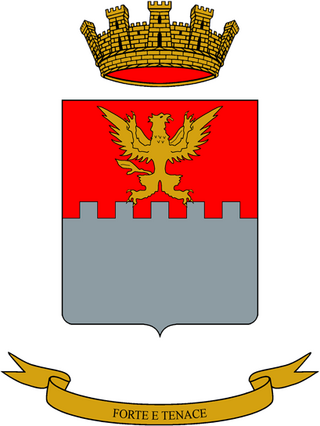
The Logistic Regiment "Pozzuolo del Friuli" is a military logistics regiment of the Italian Army based in Remanzacco in Friuli-Venezia Giulia. The battalion was formed in 1976 as Logistic Battalion "Mantova" and assigned to the Mechanized Division "Mantova". After the division was disbanded in 1986 the battalion was reorganized as a corps logistic battalion, renamed 8th Maneuver Logistic Battalion "Carso" and assigned to the 5th Army Corps. In 1994 the battalion was reorganized as 8th Maneuver Logistic Regiment "Carso". Today the regiment is the logistic unit of the Cavalry Brigade "Pozzuolo del Friuli". The regimental anniversary falls, as for all units of the Transport and Materiel Corps, on 22 May, the anniversary of the Italian Army's first major automobile use to transport reinforcements to counter the Austro-Hungarian Offensive at Asiago in 1916.
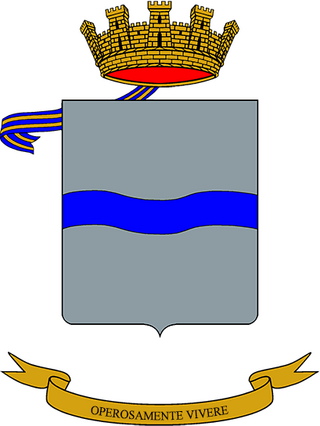
The Logistic Battalion "Mantova" is an inactive logistics unit of the Italian Army, which was assigned to the Mechanized Brigade "Mantova". The regimental anniversary falls, as for all units of the Transport and Materiel Corps, on 22 May, the anniversary of the Italian Army's first major automobile use to transport reinforcements to counter the Austro-Hungarian Offensive at Asiago in 1916.
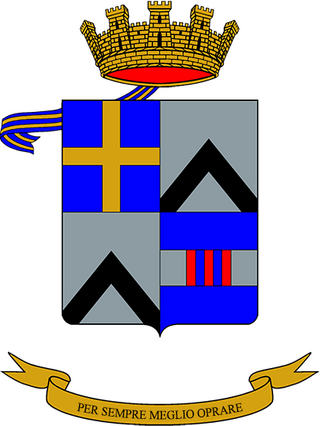
The 107th Signal Battalion "Predil" is an inactive signals unit of the Italian Army. The battalion was formed in 1946 and assigned to the Infantry Division "Mantova". In 1975 the battalion was named for the Predil Pass and received the number 107th, which had been used by the 107th Teleradio Company that served with the Combat Group "Mantova" during the Italian campaign of World War II. With the name and number the battalion also received its own flag. In 1991 the battalion was disbanded and in 2002 reformed as the second signal battalion of the deployable 7th Signal Regiment. The regimental anniversary falls, as for all signal units, on June 20, the height of the Second Battle of the Piave River in 1918.

The 120th Infantry Regiment "Emilia" is an inactive unit of the Italian Army last based in Ipplis. The regiment is named for the region of Emilia and part of the Italian Army's infantry arm.

The 114th Infantry Regiment "Mantova" is an inactive unit of the Italian Army last based in Tricesimo. The regiment is named for the city of Mantova and part of the Italian Army's infantry arm.

The 76th Infantry Regiment "Napoli" is an inactive unit of the Italian Army last based in Cividale. The regiment is named for the city of Naples and part of the Italian Army's infantry arm.
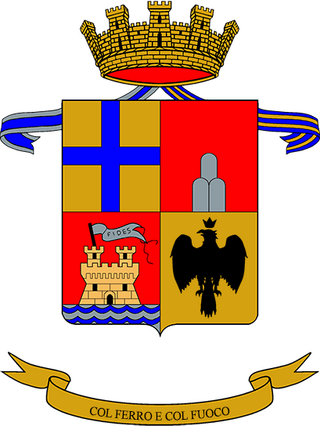
The 28th Artillery Regiment "Livorno" is an inactive field artillery regiment of the Italian Army, which was based in Tarcento in Friuli-Venezia Giulia. Originally an artillery regiment of the Royal Italian Army, the regiment was formed in 1912 and served in World War I on the Italian front. After the war the regiment was disbanded. In 1926 the regiment was reformed and in 1935 it was assigned to the 4th Infantry Division "Livorno". The division was deployed on Sicily, when the Allied landings began on 10 July 1943. In early August the remnants of the division were evacuated from Sicily and the regiment was in the process of being reformed, when German forces disbanded the division and its regiment after the Armistice of Cassibile was announced on 8 September 1943.



















